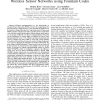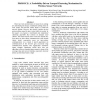346 search results - page 51 / 70 » Redundant Coverage in Wireless Sensor Networks |
MOBIHOC
2001
ACM
14 years 7 months ago
2001
ACM
The development of practical, localized algorithms is probably the most needed and most challenging task in wireless ad-hoc sensor networks (WASNs). Localized algorithms are a spe...
SECON
2008
IEEE
14 years 2 months ago
2008
IEEE
—Wireless reprogramming is a key functionality in Wireless Sensor Networks (WSNs). In fact, the requirements for the network may change in time, or new parameters might have to b...
INFOCOM
2009
IEEE
14 years 2 months ago
2009
IEEE
—We present the Flash flooding protocol for rapid network flooding in wireless sensor networks. Traditional flooding protocols can be very slow because of neighborhood content...
INFOCOM
2008
IEEE
14 years 2 months ago
2008
IEEE
—Sleep-wake scheduling is an effective mechanism to prolong the lifetime of energy-constrained wireless sensor networks. However, it incurs an additional delay for packet deliver...
AINA
2008
IEEE
14 years 2 months ago
2008
IEEE
There has been proliferation of research on seeking for distributing the energy consumption among nodes in each cluster and between cluster heads to extend the network lifetime. H...


